Hey Kids! Comics! Gifts for You and Yours
Skip to comments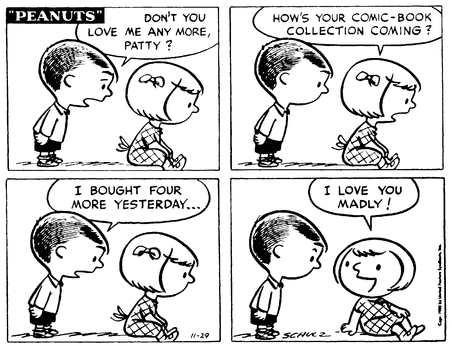
Below are some comic strip and cartoon books scheduled for November 2024 release (or so).
Images and links from a variety of publishers and outlets,
though ordering through your local comic shop or independent book store is a good idea.
This is it! The Complete Library of Lynn Johnston’s For Better or For Worse is complete!!

For Better or For Worse: The Complete Library, Vol. 9 by Lynn Johnston
The For Better or For Worse saga comes to an end in this final volume that finishes collecting Lynn Johnston’s comic strip masterpiece. A fire at Michael and Deanna’s apartment building leaves their family without a place to stay, but this coincides with John’s retirement and desire to downsize their house. April takes one last summer trip to the farm and gets a job at a veterinarian clinic. And finally, the entire cast comes together for the wedding of Elizabeth and Anthony.
This volume collects every strip from July 20, 2006, to the series’ conclusion on August 30, 2008, plus all of the new strips created for the second run in newspapers!


More Lynn!
Didn’t make the list last month but Lynn has released three more Allotabotz books in October, now six books.

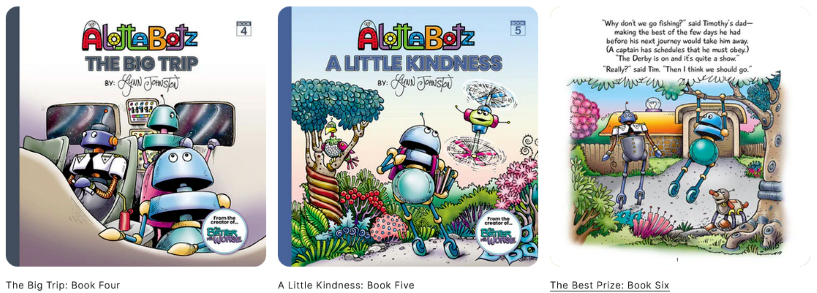
It wasn’t just Alottabotz that flew under October’s radar, there were a lotta books. Let’s go there first:

Comics Revue Presents October 2024 by various
Complete in this issue: Rick O’Shay by Stan Lynde, Buz Sawyer by Roy Crane, Sir Bagby by R&D Hackney. 19 pages of color Sunday pages featuring Flash Gordon by Dan Barry, Flash Gordon by Mac Raboy and Harry Harrison, Gasoline Alley by Dick Moores, Alley Oop by V. T. Hamlin, Casey Ruggles by Warren Tufts, Steve Canyon by Milton Caniff, and The Phantom by Lee Falk and Wilson McCoy. Plus the following stories in B&W: Mandrake the Magician, Krazy Kat, Buz Sawyer, Rick O’Shay, Sir Bagby, Garth, and Chris Welkin, Planeteer! Cover by Jeremy Macpherson.
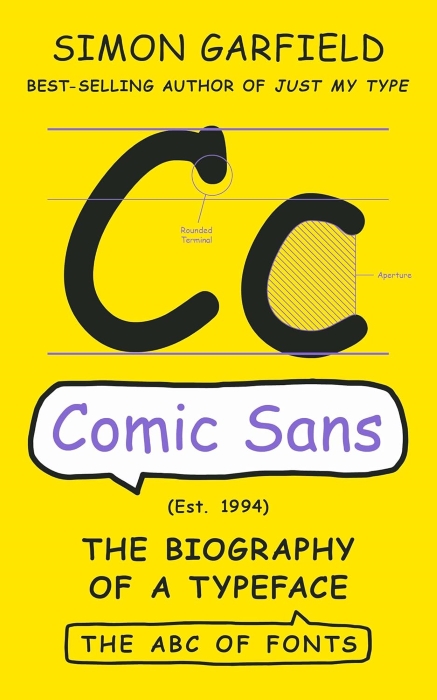
Comic Sans: The Biography of a Typeface by Simon Garfield
Since its improvised creation at Microsoft in the mid-1990s, Comic Sans has become one of the most used and talked-about typefaces of the digital age. The subject of April Fools pranks and endless internet discourse, it has spawned a movement to ban it, inspired revivals and spinoffs, and continues to be widely promoted by educators. In this delightful history, best-selling author Simon Garfield tells the story of how Comic Sans emerged from speech bubbles on educational software to become one of the most recognized—and reviled—typefaces on earth.

Deja Drabble by Kevin Fagan
One of the most hilarious comic strips of all time is back with another great collection entitled “Deja Drabble.” Join Ralph, Norman, Wally the wiener dog and other Drabble characters from the past and present. In “Deja Drabble” you’ll discover that the Drabble family had another dog before Wally, Norman had another girlfriend before Echo, Ralph was once a professional wrestler, and several other surprises!

Portfolio: The Complete Various Drawings by Mark Schultz
-Features nearly 450 drawings
-Brush-and-ink and pencil pieces, plus oil paintings are included
-Collecting all five Various Drawings books
-Highlighted with an additional 160 pages worth of material not previously collectedA compelling showcase spanning seven transformative years.
During an impressive period—2005 through 2012—Mark Schultz turned his attention to producing a body of personal works and private commissions, focusing on subjects about which he feels most passionate. Among them are characters and tableaux pulled from mythology, science-fantasy and pulp adventure.

Swami Salami: The Best of the Beloved Woodstock Times Cartoons by Michael Esposito (background)
Michael Esposito played in the 1960s psychedelic rock band the Blues Magoos. The band’s (We Ain’t Got) Nothin’ Yet peaked at number five on the Billboard Charts, and they toured nationally with Herman’s Hermits and The Who. After they broke up in 1968, Michael moved to Woodstock and became a monk for a decade under Father Francis. During the 1970s, he began submitting Swami Salami cartoons to the Woodstock Times—a gig that lasted forty years.
This softcover title has 368 pages, a trim size of 8½ by 5½ inches, and includes 341 cartoons. Bushwhack Books published it in 2024.

My Time Machine by Carol Lay
My Time Machine takes off when Carol Lay’s silver-haired protagonist (who happens to resemble the author) embarks on a foolhardy odyssey that transports her from the politically addled and environmentally anxious America of 2020 to a bleak and distant future. “When I came to, I had that ‘Where am I?’ feeling.
“Only it was more like, ‘When am I?’”Carol Lay’s My Time Machine is serious and funny, a sly cautionary political satire, and a rollicking time travel story full of puzzling paradoxes, edge-of-your-seat suspense, breezy badinage, and a deeply felt wonder at the universe.
On to November 2024:

American Comic Book Chronicles: 1945-1949 by Keith Dallas and John Wells
At long last, this 1945-49 volume covers the comic book industry during the aftermath of World War II, when scores of writers and artists returned from foreign battlefields to resume their careers. It was a period when readers began turning away from the escapist entertainment offered by super-heroes in favor of other genres, like the grittier, more brutal crime comics. It was a time when Joe Simon and Jack Kirby created Young Romance, inaugurating a golden age of romance comics. And it was during this five-year period that Timely and National Comics capitalized on the popularity of Westerns, that Bill Gaines plotted a new course for EC Comics in the wake of his father’s death, and that Jerry Siegel and Joe Shuster first sued for the rights to Superman. These are just a few of the events chronicled in this exhaustive, full-color hardcover, further documenting the ACBC series’ cohesive, linear overview of the entire landscape of comics history!

Lars the Awkward Yeti Volume 2 by Nick Seluk
Lars The Awkward Yeti is an ongoing gag-a-day webcomic by New York Times best-selling author Nick Seluk. Started in 2012, the comic follows the daily life of Lars, a socially awkward blue yeti, trying to get by in day-to-day life. Lars organs, Heart & Brain, have spawned their own empire of hit books and merchandise. This is the
first[second] of a trilogy of collected editions of Lars stories, past and present, where it all started.

Rube Goldberg’s Big Book of Building by Jennifer George and Zach Umperovitch; Illustrated by Ed Steckley
To build a Rube Goldberg Machine, all you need is a pile of junk and a great imagination. Rube Goldberg’s granddaughter, Jennifer George, has teamed up with world-renowned Rube Goldberg machine builder Zach Umperovitch to show us just how true that is in this comprehensive guide to building Rube Goldberg Machines at home…Progressing in difficulty with each chapter, kids (and builders of all ages) will learn how to construct super simple machines that fit on a tabletop, to hard ones that take up entire rooms or yards! Learn how to start chain reactions that refill your popcorn automatically on movie night, open umbrellas, and even pack a picnic, one step at a time. Filled with jokes, fun facts, and tips and tricks to make building as successful as possible.
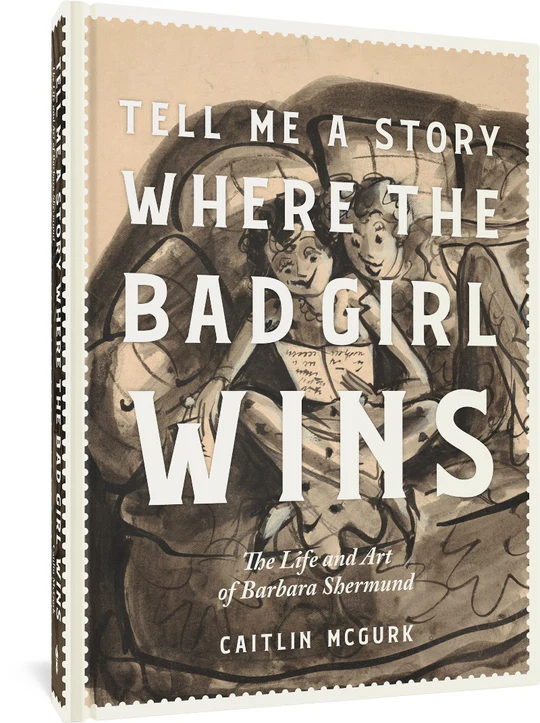
Tell Me a Story Where the Bad Girl Wins: The Life and Art of Barbara Shermund by Caitlin McGurk
Tell Me a Story Where the Bad Girl Wins doubles as an official biography and coffee table art collection honoring the life and art of pioneering cartoonist Barbara Shermund, an unheralded early master of magazine cartooning whose career spanned the heyday of American magazines from the 1920s–1960s. Her sharp wit and loose style boldly tapped the zeitgeist of first-wave feminism with vivid characters that were alive and astute.
As one of the first women cartoonists to work for The New Yorker the year of its launch in 1925, she created nine covers and more than 600 cartoons for the magazine, in addition to countless spot illustrations, giving the nascent publication its unique visual brand. Shermund later became a mainstay at Esquire; contributed to Life, Colliers, Judge, and more; had a syndicated newspaper cartoon published by King Features; and illustrated a variety of books. In 1950, Shermund was among the first three women to be accepted as a member of the male-dominated National Cartoonist Society.

Peanuts: You’re the Greatest Charlie Brown by Charles M. Schulz
The latest edition in Titan Comics hugely popular Peanuts Facsimile series sees the release of this, the 16th volume in the series and features 126 pages of classic Peanuts daily newspaper strips from 1963 and 1964.

All In Line by Saul Steinberg
To escape fascist Europe, the artist Saul Steinberg drew his way to America. He made it to New York in 1942 already in contract with The New Yorker, but was soon called up to serve in the US Naval Reserve in World War II. This book, All In Line, is a memoir-via-drawing of this key time in Steinberg’s life, when he began to find his line and his way as an American.
This new edition of All in Line includes an introduction by cartoonist Liana Finck, an afterword by Steinberg scholar Iain Topliss on the making of the book, and full captions with notes. It will resonate with both lifelong Steinberg fans as well as those who are encountering his work for the first time.

Museum of Degenerates: Portraits of the American Grotesque by Eli Valley
Museum of Degenerates invites you to a delirious display of art by one of contemporary America’s most original and incendiary political cartoonists. Eli Valley’s extraordinary work is a scathing indictment of the entire American polity, with a particular focus on the issues of Israel and Judaism at a time when these have moved to the center of public debate and action.
In these pages, Valley tips a homburg to German expressionists such as George Grosz and Otto Dix who featured in “The Exhibition of Degenerate Art,” a 1937 Munich show that sought to ridicule the work of artists critical of Hitler’s fascist regime. In an aesthetic that is strikingly original, Valley also draws on early twentieth-century American Yiddish cartoons and the work of artists who created the helter-skelter exuberance of MAD comics in the 1950s.

What If? 10th Anniversary Edition by Randall Munroe
A special 10th anniversary edition of the million-copy bestseller What If? from the creator of the wildly popular webcomic xkcd—revised and annotated with brand-new illustrations and answers to important questions you never thought to ask.
In celebration of 10 years of unusual insight, Randall Munroe has revised his classic blockbuster to ask what if? x 10. The result is 10x the adventure of scientific inquiry. Featuring brand-new 2-color annotations and illustrations, this special anniversary edition is far more than a book for geeks, What If? explains the laws of science in operation in a way that every intelligent reader will enjoy and feel much smarter for having read.

Redrawing the Western: A History of American Comics and the Mythic West by William Grady
Redrawing the Western charts a history of the Western genre in American comics from the late 1800s through the 1970s and beyond. Encompassing the core years in which the genre was forged and prospered in a range of popular media, Grady engages with several key historical timeframes, from the origins of the Western in the nineteenth-century illustrated press; through fin de siècle anxieties with the closing of the frontier, and the centrality of cowboy adventure across the interwar, postwar, and high Cold War years; to the revisions of the genre in the wake of the Vietnam War and the Western’s continued vitality in contemporary comics storytelling.

A New Zealand Diary: Living in Lyttelton by Alex Hallatt (more from Alex)
Lyttelton isn’t your typical Kiwi town. Nestled in an extinct volcano’s crater, it’s a working port where history and modern life clash in ways that’d make your head spin. This book peels back the layers of a place that’s more than just a gateway to Christchurch. It’s a town where you’re as likely to run into an artist as a stevedore, where Facebook arguments about port noise are a spectator sport, and where the iconic timeball still keeps time (when it’s not being rebuilt after an earthquake). From the tunnel that connects Lyttelton to the ‘big smoke’ to the hills that cut the winter sun short at 2 pm, this book will take you through a year in the life of this odd little town. It’s a place where resilience isn’t just a buzzword, it’s a way of life – because when you live in Lyttelton, you learn to roll with the punches, whether they’re coming from Mother Nature or the local planning committee.
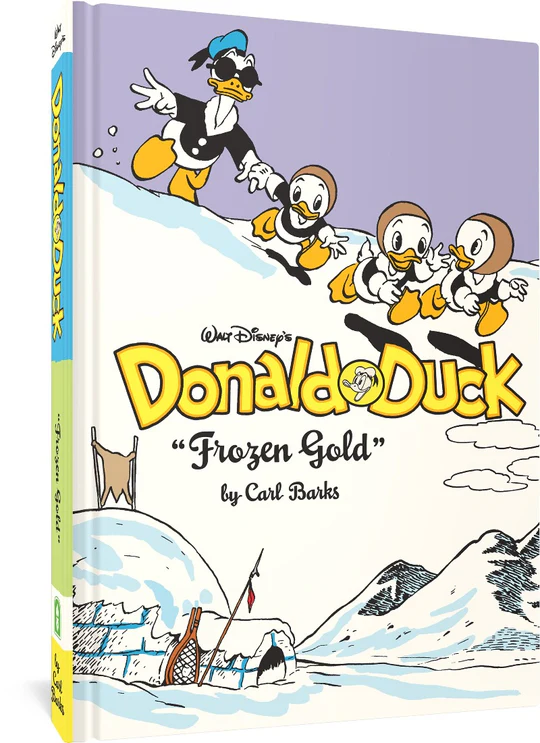
Walt Disney’s Donald Duck “Frozen Gold”: The Complete Carl Barks Disney Library Vol. 2 by Carl Barks
Kidnapped, Donald escapes, only to wander hopelessly in the far frozen north! Next, he invents a rocket fuel powerful enough to send him to the moon!
As we circle back to Carl Barks’s earlier stories, the Good Duck Artist delivers another superb collection of surprise, delight, comedy, adventure, and all-around cartooning brilliance. Eighteen stories in all in more than 200 pages of story and art, each meticulously restored and newly colored. Plus, insightful story notes by an international panel of Barks experts.

The Art of Popeye: A Masterwork of the Medium by R. C. Harvey
When cartoonist Elzie Segar created Popeye as a minor character ten years into the run of the Thimble Theatre strip in 1929, little did he know that the world’s most famous sailor would still be around over ninety years later and still in the Sunday papers. To celebrate Popeye, the character, the comic strip and his universe, Hermes Press is publishing the definitive art monograph on the subject. This book features a comprehensive essay written by pop culture historian R.C. Harvey accompanied by over 350 illustrations of original strip and comic book art, animation art, advertising art, products, the Robert Altman film, and everything Popeye, from Olive Oyl and Eugene the Jeep to Wimpy and Bluto.

Fowl Language: Tweenage Wasteland by Brian Gordon
Everyone thinks the baby stage is hard, then the toddler stage, but have you even met teens and tweens? They will eff your sh!t UP. The latest installment of Fowl Language by cartoonist Brian Gordon is something all parents of kids 10 and older can empathize with. (And maybe cry along to.)

Woman & Man+ by Craig Yoe
Woman & Man+ is a wildly surreal autobiographical telling of its artist, Yoe, losing his love, his country, and, some say, his sanity–and his struggle to reinvent himself.
The highly anticipated loudly wordless graphic novel Woman & Man+has a revolutionary approach that breaks all the rules of conventional comic storytelling. Steranko meets Hieronymus Bosch by way of R. Crumb and Dali. The unique art style has been deemed, “Yoe-Brow”!

Popeye Volume 4: Swee’Pea & Eugene the Jeep (The E. C. Segar Popeye Sundays)
In the fourth and final volume of the E.C. Segar Popeye Sundays, meet the most whimsical character of the Popeye universe!
This dynamic concluding volume introduces a curious creature from the fourth dimension — Eugene the Jeep! The minute this mysterious marvel with the power of teleportation arrives on the scene, the strip is infused with an oddball, otherworldly quality. Elsewhere, Wimpy continues his befuddling antics; the wily orphan Swee’Pea and the patriarch Poopdeck Pappy cause domestic hijinks; and Popeye does battle with the big bad Man from Mars! Plus, contemporary artist Kayla E. pens a comic homage to the topsy-turvy character headlining this volume.

At Wit’s End: Cartoonists of The New Yorker by Alen MacWeeney and Michael Maslin
An exclusive sneak peek inside the creative minds of more than 50 New Yorker cartoonists, celebrating legends and newcomers alike with stunning photography and engaging profiles.
feature image: Zippy by Bill Griffith


Comments 1
Comments are closed.